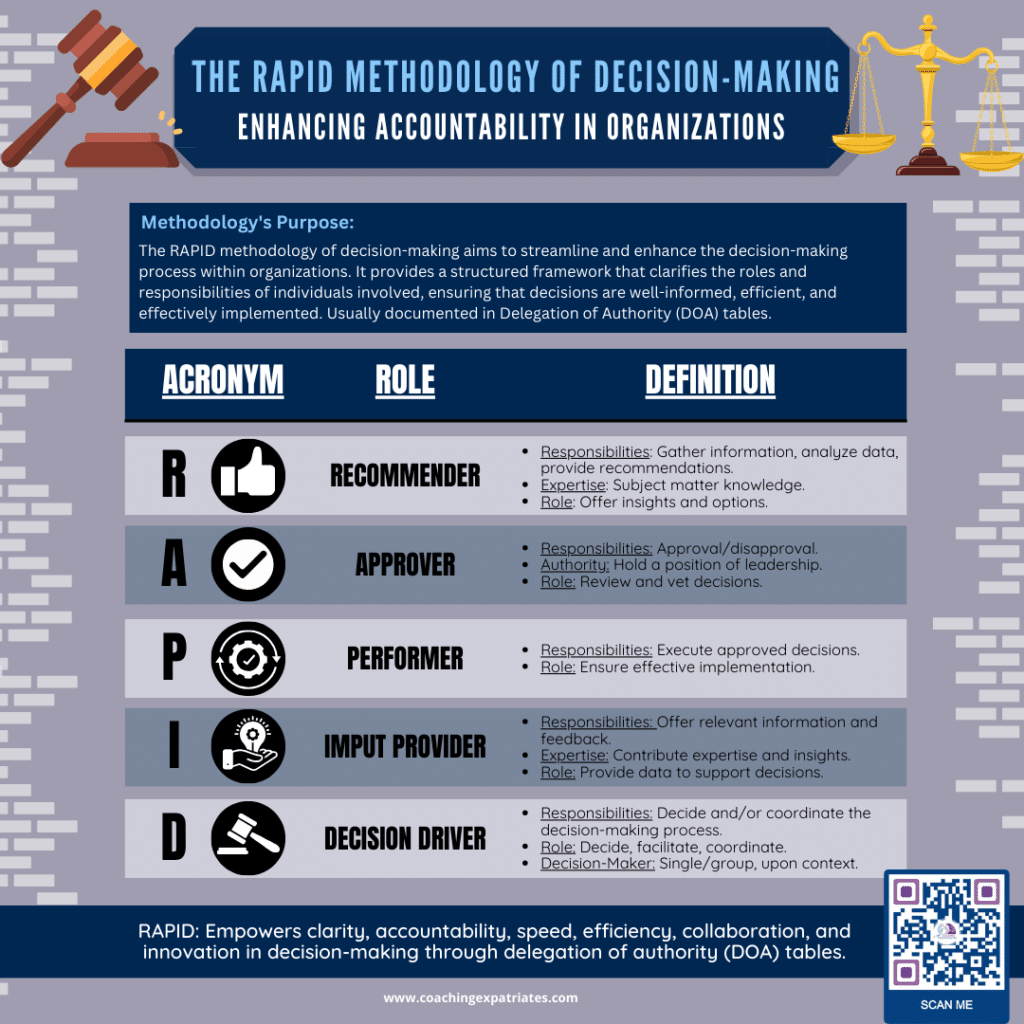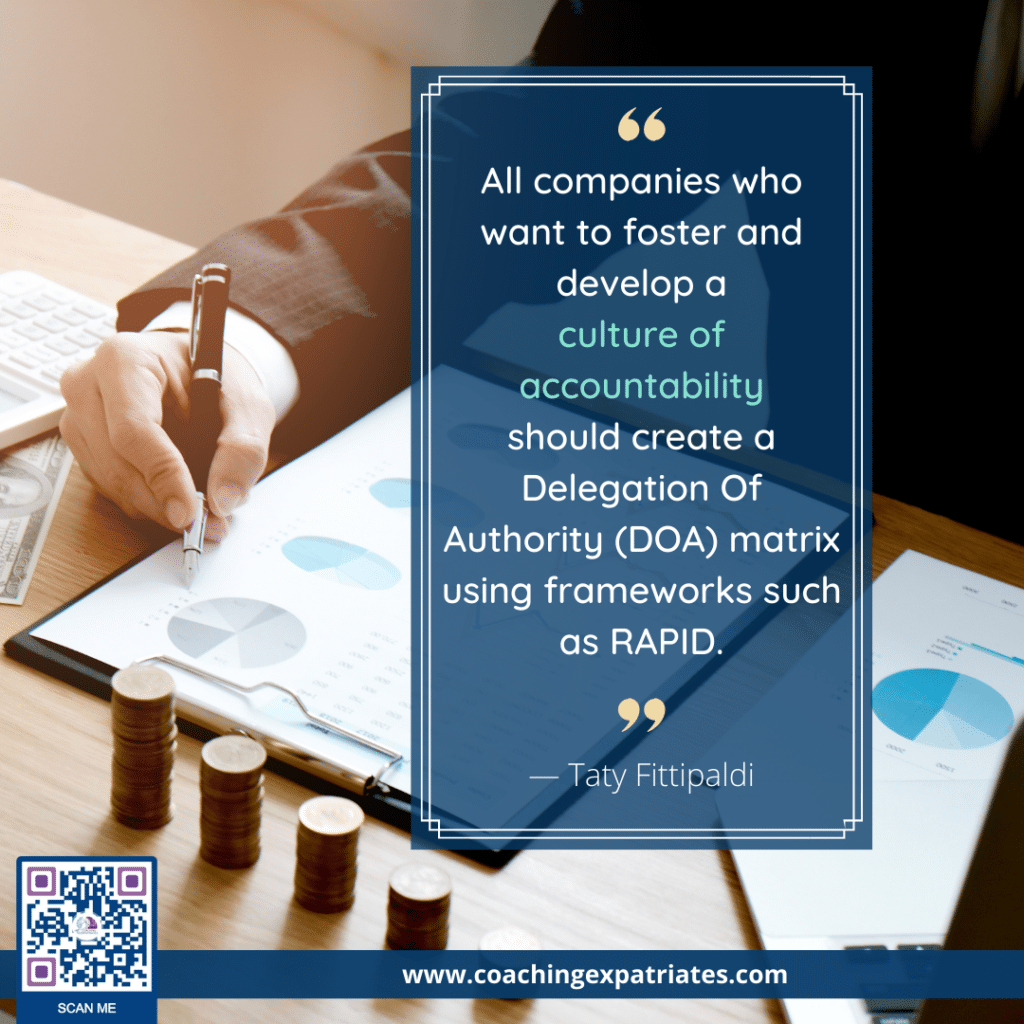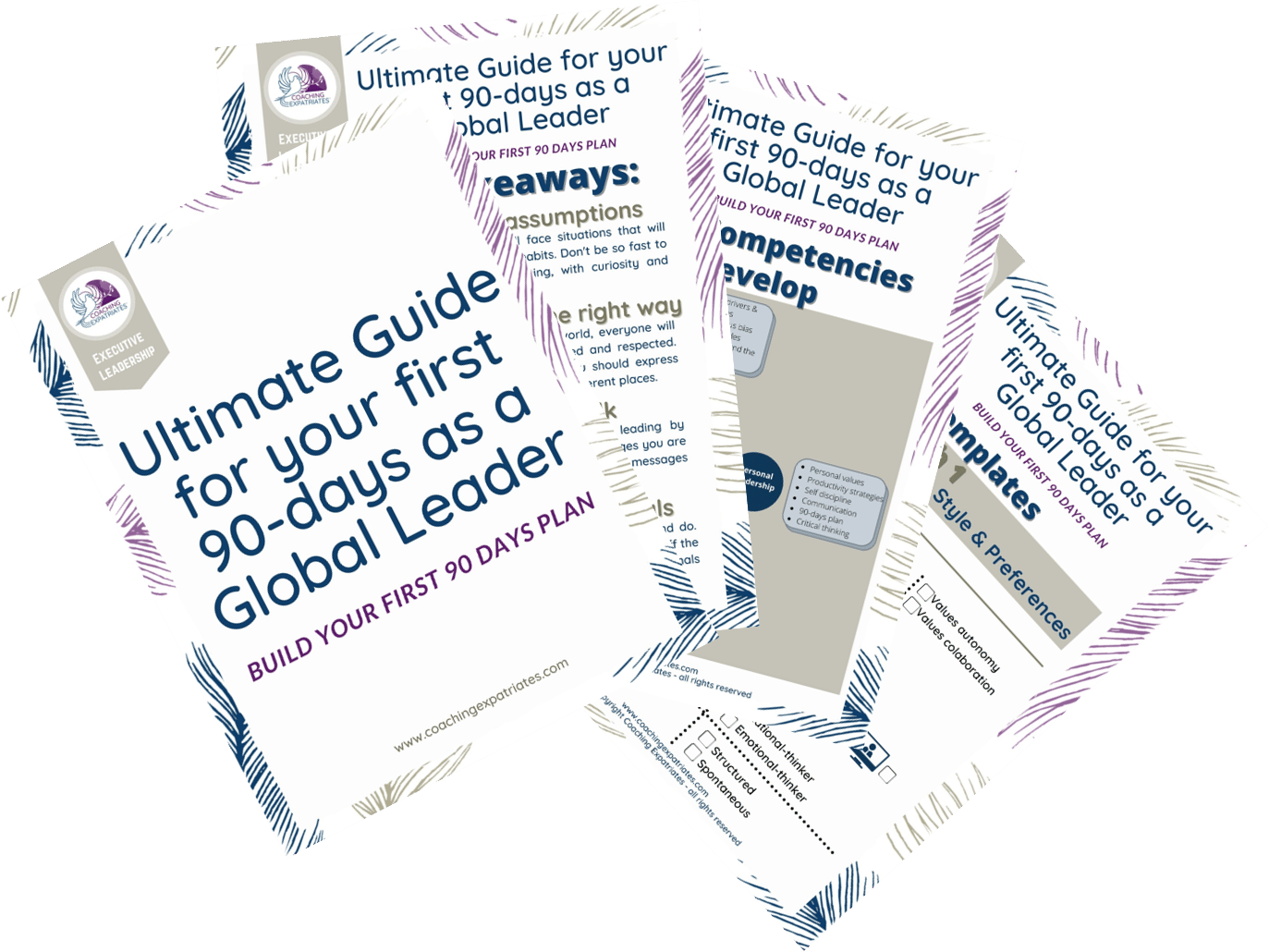Making informed decisions swiftly and efficiently is paramount in global environments, and the bigger a company is, the more difficult this becomes. How about we enter the RAPID decision-making framework – a powerful tool that has gained significant traction among companies aiming to streamline their decision-making processes?
In this comprehensive blog post, we’ll embark on a journey through the world of RAPID Process for decision-making when creating Delegation Of Authority (DOA) tables inside companies, delving into its origins, relevance to businesses, and practical implementation strategies. We’ll explore when to deploy the RAPID methodology, understand the challenges it may pose, and even take a close encounter of the first kind with Delegation of Authority (DOA) tables and their complexities. Additionally, I’ll provide a real-world example of a decision-making process using RAPID, suggest effective ways to store and share your Delegation of Authority (DOA) table, and recommend books that can elevate your decision-making prowess. So, let’s navigate the intricate landscape of decision-making with the RAPID framework!
What Is The RAPID Methodology Of Decision-Making?
RAPID is a business acronym that stands for the key roles and responsibilities involved in decision-making within an organization. It’s a process and framework to improve decision accountability and facilitates the decision-making for every single person participating in a process.
Each letter in the acronym represents specific input roles or groups of individuals who play a part in the decision-making process:
- R – Recommend: The Recommender is responsible for gathering information, analyzing data, and making recommendations based on their expertise and knowledge of the subject matter. They provide valuable insights and options for decision-makers to consider.
- A -Agree: The Approver is the person or group with the authority to give approval or disapproval of a decision. They have the ultimate responsibility for agreeing or vetting a decision and often hold a position of authority or leadership within the organization.
- P – Perform: The Performer is responsible for executing the decision once it has been approved. This role ensures that the chosen course of action is carried out effectively and efficiently.
- I – Input: The Input Provider is responsible for providing relevant information, data, or feedback to the decision-making process. They may not make recommendations or have approval authority but contribute by offering their expertise or insights.
- D – Decide: The decision-maker(s) is(are) the driver(s) responsible for deciding and/or coordinating the decision-making process, ensuring that the right people are involved, and that the decision moves forward in a timely manner. They help facilitate communication and collaboration among the other roles. The “D” could be a single decision-maker or a whole group of people, depending on the decision at hand and/or the decision-making approach the company’s culture adopts.

The RAPID framework is often used to clarify decision-making responsibilities within organizations, helping to streamline the process and ensure that decisions are made in a structured manner with relevant input from the right people. It’s a helpful tool for improving decision-making efficiency and accountability in the chain of command.
Who Created The RAPID Decision-Making Framework?
The RAPID decision-making framework was pioneered by Bain & Company, a prominent global management consulting firm. This innovative model was developed by Bain & Company to enhance the efficiency and clarity of decision-making processes within organizations. In 2006, 2 people from the Bain Company published a long, elaborate article about this framework in the Harvard Business Review.
Bain & Company, founded in 1973, has a long-standing reputation for providing strategic insights and solutions to a diverse range of industries and clients worldwide. Drawing upon their extensive experience in management consulting, the company recognized the need for a structured approach to decision-making that would ensure that the right individuals were involved in the process and that their roles were clearly defined.
The RAPID model, which stands for Recommend, Agree, Perform, Input, and Decide, was born out of this need. As you noticed, it assigns specific roles to individuals involved in decision-making, making it easier for organizations to navigate complex choices, allocate responsibilities, and foster a culture of accountability.
This framework has since been adopted by numerous organizations across various industries. This model has played a pivotal role in optimizing decision-making processes, promoting collaboration and high-quality decisions, and ultimately driving better outcomes for businesses and their stakeholders.
All companies who want to foster and develop a culture of accountability should create a delegation of authority (DOA) matrix using frameworks such as RAPID.

Why Is The RAPID Decision-Making Framework So Relevant To Companies?
The RAPID decision-making framework is like the secret sauce that companies have been craving for ages. It’s relevant for several types of decisions, and it’s a game-changer for several reasons. Let’s dive into why businesses are loving it:
- Clarity and Accountability: RAPID spells out who’s doing what in decision-making. It’s like having a roadmap that tells you exactly where to go. This clarity ensures that everyone knows their role, making accountability crystal clear. No more finger-pointing or confusion about who dropped the ball.
- Faster Quality Decisions: In the corporate world, time is money. With RAPID, decisions get made faster. And not just any decisions, quality decisions. There’s no more waiting around for endless meetings or wandering in the decision-making wilderness. When you know who’s in charge, things move swiftly, and it’s more a matter of presenting a business case than creating a process from scratch.
- Efficient Resource Allocation: Companies often have limited resources. RAPID helps allocate those resources more efficiently with greater strategic financial management in mind. Instead of having everyone provide input or make decisions, you can focus on the people who truly matter for a particular choice. It’s like optimizing your decision-making engine.
- Improved Collaboration: Collaboration is the name of the game in today’s business world. RAPID encourages teamwork by involving the right people at the right time. This fosters better communication and harnesses the collective wisdom of your team.
- Reduced Risk: When you have the right people making decisions, you reduce the risk of making costly mistakes. RAPID minimizes the chances of poor choices slipping through the cracks.
- Enhanced Innovation: By involving the right voices in decision-making, RAPID promotes innovation. You tap into diverse perspectives, which can lead to more creative solutions and better outcomes.
In a nutshell, the RAPID decision-making framework is relevant because it’s like a well-oiled machine that provides all different types of organizations with greater decision-making power. It ensures decisions are made efficiently, transparently, faster, and with everyone pulling in the same direction. However, going into the same direction doesn’t mean taking the same path there.
Depending on company size, departmental purpose, and global region, among other unique factors inside a business, creating RAPID decision-making delegation of authority tables may differ to attend to specific needs. Let’s talk about that.
Global Versus Local
As the consultants from the Bain company put in their HBR article, “The trick in decision making is to avoid becoming either mindlessly global or hopelessly local.” It’s important to cater to both global and local needs on equal terms. You cannot assume that the procurement process will look like the same in all regions of the globe. To gain the mentioned benefits, companies will have to balance local needs (including customer preferences) versus global consistency in processes and workflow. Start mapping out the processes that need consistency across the globe and those that can be customized and customer-centric based on localization.

Cost Center x Business Unit x Corporate
For companies that might not be global but might have more than one business unit, having a balancing act between delegation of authority by department or cost center, versus more centralized matters might be crucial. For example, people in decision of governance topics might be decided on a more corporate, centralized level, while more processual things might be done at the business unit and/or cost center level. Making procurement part of the example again, hiring a new vendor could be done at a business unit level, for all cost centers, while establishing decision criteria for new vendors could be done at a centralized level. As I said, each organization is unique and will demand its own table creation.
Function Versus Cross-Functional
I once coached a lady who had many challenges with “gray zone” decisions in her company. Certain decisions impacted more than one department; therefore, all these departments wanted to be the “D” on the matter. In other words, the final decision-makers. When creating a delegation of authority table using RAPID decision-making methodology, getting our department’s functional tasks and activities into the table is the easiest part. The challenging part is when cross-functional matters arise.
Since I loved my client’s challenge so much, I will detail it here for your benefit as well. She directed a whole customer service B2B department with more than 500 employees. At one point in time, before she came on board with her company, the product team defined the billing fees and terms that her department would charge the other companies for this B2B service. Once she took over her executive director job, she started noticing flaws in these billing fees and how they impacted her department’s revenue, metrics, and bonuses. Although her company was pretty big, they didn’t have any documented process for decision authority and who should decide on what. And that’s why one department could propose and get approved for a decision that would completely affect another department altogether! The reason why they got away with this was because “the product” had a certain service level agreement embedded in it, so they wanted to ensure “the product was delivering the promise.”
So, it’s understandable that they – the product team department – don’t want their promise to fall flat in the face of their clients, but at the same time, it makes no sense to overstep another department’s decision and accountability for service delivery. This is the gray zone we are talking about.
That’s why documenting cross-functional processes and all its steps of the process in a delegation of authority table using RAPID (or any other decision-making role assignment methodology) will allow greater clarity for all, and much less conflict between teams.
Many of these tables are separated by departments, but this section’s purpose is purely to remind you about the grey zones and how important they are to document as well. Even more so than regular functional activities!
It took a long time for my client to complete this authority table initiative, but once she did, the clarity it gave the top leadership members helped them, and their teams, work more smoothly and efficiently. On top of that, her influence power inside the company increased immensely as she established a network of connections across multiple departments and levels in the company.
When To Use The RAPID Methodology?
The RAPID framework, despite its name, isn’t a one-size-fits-all solution. Its strength lies in thoughtful and structured decision-making, which may not always align with every situation.
Here’s when you should consider using the RAPID framework:
- Complex Problems: RAPID shines when you’re dealing with complex, multifaceted issues. It’s designed to handle situations where various factors need consideration, and involving multiple stakeholders is crucial for making an informed choice. The structured approach ensures that all perspectives are heard and accounted for.
- High-Stakes Decisions: When the stakes are high, and the consequences of a decision significantly impact your organization, RAPID is your friend. It provides a safety net, reducing the risk of costly mistakes by involving the right people in the decision-making process.
- Need For Diverse Input: If your decision would benefit from a range of perspectives and expertise, RAPID is a valuable tool. It encourages cross-functional collaboration, allowing teams with different knowledge and skills to contribute to the decision.
- Accountability Is Critical: When accountability is paramount, RAPID ensures that everyone knows their role and responsibilities in the decision-making process. This clarity fosters accountability and minimizes confusion.
- Transparency and Communication: If you want to enhance transparency and communication within your organization, RAPID can help. By clearly defining who does what, it promotes open and effective communication among team members.
However, there are scenarios where RAPID might not be the best fit:
- Simple Problems: For straightforward, routine decisions that don’t require extensive analysis or input from various stakeholders, RAPID can be overkill. In such cases, a more streamlined decision-making process may be sufficient.
- Time-Sensitive Decisions: RAPID’s structured approach, with its various roles, may slow down the decision-making process. When time is of the essence, and a quick response is needed, simpler decision-making methods may be more appropriate.
- Single Decision-Maker Situations: If a decision can be made by one person with the requisite authority and expertise, there’s no need to involve multiple roles as prescribed by RAPID.
The RAPID framework is a valuable tool for making thoughtful, well-informed decisions in complex situations that require diverse input and accountability. To determine whether to use RAPID, consider the complexity of the problem, the stakes involved, the need for diverse perspectives, and the desired level of accountability and communication within your organization.
How To Implement RAPID Decision Making?
Let’s explore how to implement the RAPID model in both mid-sized and large corporations, considering the unique challenges that come with each scale.
Implementing RAPID In Mid-Sized Corporations:
Implementing the RAPID model in mid-sized corporations can significantly enhance decision-making efficiency and clarity. Here’s a step-by-step guide:
- Assess Organizational Readiness: Begin by assessing your organization’s readiness for adopting the RAPID framework. Ensure that leadership and key stakeholders understand the benefits and are willing to commit to the necessary changes.
- Start with Pilot Projects: It’s often a good idea to start with smaller, less complex projects to test the waters. Select a few decision-making processes where RAPID can be applied effectively. This allows your teams to become familiar with the framework gradually.
- Customize Roles and Responsibilities: Tailor the RAPID roles (Recommend, Approve, Perform, Input, Decide) to suit the specific needs and structure of your mid-sized company. Ensure that role definitions are clear, and responsibilities are well-understood.
- Train and Educate: Invest in training and educating your teams about the RAPID model. Ensure that everyone knows their roles and understands how to navigate the decision-making process using RAPID. Professional coaching for key decision-makers can be very helpful during the implementation to help change the mindset and behavior for driving decision-makers.
- Communicate and Collaborate: Emphasize the importance of effective communication and collaboration. Mid-sized organizations often have the advantage of being more agile, so encourage open dialogue among stakeholders involved in decisions.
- Monitor and Adjust: Continuously monitor the implementation of RAPID in your mid-sized corporation. Collect feedback and be ready to make adjustments to role definitions and processes as needed to improve efficiency and effectiveness.
Implementing RAPID In Large Corporations:
In large corporations, the complexities of scale and hierarchy can pose unique challenges. Here’s how to navigate them:
- Top-Down Support: Gain strong support from top leadership, including executives and senior management. Their endorsement is critical in driving the adoption of RAPID throughout the organization.
- Pilot Programs: Similar to mid-sized corporations, start with pilot programs to demonstrate the benefits of RAPID. Large corporations often have multiple divisions or business units, making it advisable to begin implementation in one area as a pilot.
- Customize For Each Division: Recognize that different divisions or departments within a large corporation may have distinct needs and structures. Customize the RAPID model to fit these unique requirements while maintaining consistency in core principles.
- Change Management: Large organizations often have entrenched decision-making processes. Effective change management is essential to overcome resistance and ensure a smooth transition to the RAPID model.
- Technology Support: Consider leveraging technology to facilitate RAPID implementation in large corporations. Decision-making software and tools can help manage and track the roles and responsibilities of various stakeholders.
- Scalable Training: Develop scalable training programs and resources to educate a large and diverse workforce about RAPID. Webinars, online courses, and documentation can be invaluable in this context. Don’t forget executive coaching as a key behavioral and mindset change tool in these types of big cultural transitions.
- Continuous Improvement: Large corporations must adopt a culture of success and continuous improvement. Regularly review and refine the RAPID implementation, keeping an eye on evolving organizational needs and challenges.
In both mid-sized and large corporations, RAPID can be a powerful tool for streamlining decision-making. However, the key lies in recognizing the specific nuances and challenges of your organization’s size and structure and tailoring the implementation accordingly. That is one of the main reasons why companies who want to undergo this type of implementation usually hire consulting companies to help them through the process, from the RAPID table creation to the cultural change management.
With commitment, clear communication, the right resource allocation, and a focus on adaptability, RAPID can become a valuable asset for effective decision-making across the corporate spectrum. If your company doesn’t have one, you should definitely consider exploring this option.
Challenges To RAPID Decision-Making
While this framework sounds awesome, it certainly has its share of challenges. Let’s explore the challenges associated with the RAPID Decision-Making Model, which, while a powerful tool, does have its limitations you should consider before implementing it:
- Organizational Buy-In: One of the primary challenges of implementing the RAPID model is securing buy-in from the entire organization, from top-level management to frontline employees. Achieving this alignment can be a complex task, as it necessitates a cultural shift towards a more collaborative and structured decision-making approach. Some employees and leaders may resist this change, which can hinder successful adoption.
- Potential Decision-Making Delays: The RAPID model, with its focus on involving multiple stakeholders and assigning distinct roles, can sometimes slow down decision-making processes. This framework is ideally suited for larger and more critical decisions, where careful consideration is crucial. However, for routine or time-sensitive choices, its structured approach may be overly cumbersome.
- Complexity: The RAPID model introduces additional complexity to decision-making. With multiple roles involved (Recommend, Agree, Perform, Input, Decide), it requires clear role definition, communication, and coordination. This complexity can lead to confusion or inefficiencies if not implemented thoughtfully and in large-scale internal communication.
- Resource Intensiveness: Implementing RAPID effectively may require dedicating resources to training, communication, and ensuring consistency in its application. This can be resource-intensive, and organizations must be prepared to invest time, effort, and money to reap the framework’s benefits.
- Limited Applicability: RAPID is not a one-size-fits-all solution. It’s best suited for significant decisions that warrant a structured approach. Using it for every decision, regardless of its size or importance, can lead to unnecessary bureaucracy and delays.
- Resistance to Change: Just like any new approach, RAPID may face resistance from individuals or teams accustomed to traditional decision-making methods. Overcoming this resistance and fostering a culture that embraces the RAPID model can be a hurdle.
- Communication Challenges: Effective communication is pivotal in RAPID. Ensuring that information flows smoothly among different roles can be challenging. Communication breakdowns can disrupt the decision-making process.
- Adaptability: The RAPID model may not be suitable for all organizations or decision scenarios. Knowing when to apply it and when to use alternative decision-making methods that better align with specific needs is a decision in itself.
The RAPID Decision-Making Model offers a structured and accountable approach to decision-making, but it’s not without its challenges. Organizations should carefully consider these challenges and weigh them against the benefits to determine the most suitable decision-making approach for each situation.
What Other Similar Frameworks Exist Out There?
Several similar frameworks and methodologies exist for clarifying decision-making roles and responsibilities in big corporations. Some of these frameworks include:
1 – DACI: DACI is an acronym that stands for Driver, Approver, Contributor, and Informed. It’s a framework similar to RAPID and is used to define roles in decision-making processes. Each role has a specific function:
- Driver: The person responsible for driving the decision-making process.
- Approver: The person with the authority to approve or reject the decision.
- Contributor: Individuals who provide input, information, or expertise to inform the decision.
- Informed: Those who need to be kept informed about the decision but are not directly involved in the process.
2 – RASCI: RASCI – which sometimes is also seen only as RACI, excluding the supporting role – is another acronym-based framework used to clarify roles and responsibilities in decision-making:
- Responsible: The person or team responsible for executing the decision.
- Accountable: The individual ultimately responsible for the decision’s success or failure.
- Supportive: People or teams that provide assistance or resources to those responsible for execution.
- Consulted: Individuals or groups whose input or expertise is sought before the decision is made.
- Informed: People who need to be kept informed about the decision.
3 – OARP: OARP stands for Owner, Approver, Reviewer, and Performer. This framework is used to define roles in decision-making processes and project management:
- Owner: The person accountable for the decision or project’s success.
- Approver: The individual with the authority to approve or disapprove of the decision or project.
- Reviewer: People who review and provide feedback on the decision or project.
- Performer: Those responsible for carrying out the tasks and actions related to the decision or project.
These frameworks, like RAPID, are designed to help organizations clarify decision-making roles and create role assignment tables to improve the efficiency and effectiveness of their decision-making processes. The choice of framework may depend on an organization’s specific needs and preferences, but the fundamental goal is to ensure clear accountability and communication in decision-making.
RAPID Close Encounter Of The 1st Kind
I recently coached an individual who worked for a super mega big credit card global corporation, who was having a lot of trouble making decisions. When we first set her goals, her boss’s feedback was that she needed to make more assertive decisions. In our first calls, I tried to ascertain her actual problem with decision-making.
“Decisiveness,” she pondered. She thought she was not decisive and did not know the right timing for decisions. After deeper investigation and conversations, I identified that she was actually quite assertive in making decisions, and she knew exactly what to do and when to make decisions. She was even good at articulating and coordinating the decisions to happen. So, what was her problem then?
Her problem was a lack of knowledge of decision-making authority. In other words, she didn’t know what she could or could not decide on. Companies that do not have a Delegation Of Authority table (DOA) suffer from this. Their executive directors do, at least. Especially because they frequently overstep each other. Of course, they do; there are no formal instructions about who decides on what, right?
My first encounter with a DOA table was early in my career when I worked for General Electric. Their DOA table was quite impressive. I quite honestly never saw something as robust as theirs. I worked in various divisions within that company, and each division had its own DOA. What was not on the division’s DOA, was outside our division’s authority for decision.
What made their table so impressive was that it not only had role assignments but also included budget levels and authority levels. For example, signing new contracts with vendors had their decision role assignments depending on the contract amount. If I were purchasing a unit-wide training that cost $500,000 dollars, the role assignments would be different from a department-wide training that cost $50,000. Back then, they used a table that was a mix of RASCI, RAPID, and OARP in the role assignments, which contributed to making it very robust and complete. For example, the “owner” could assign a person in their team to be the “responsible.” The “Approver” could be a stakeholder of the “owner,” and the “reviewer” could be someone from another division, depending on the topic. So, as you can see, this can get very complex but very helpful, especially in large corporations. They even had email contacts for the “chairs” involved in each decision.
When I got there, those tables were already there, so I cannot speak to how difficult it was to get to that level of table development. But my first encounter was a valuable experience to me, because it taught me that each company is unique and, therefore, needs a unique delegation of authority table as well. And that’s why I don’t advise buying templates in the market. They are great for ideation but not really for your implementation. If you purchase any with this midset, you’re good.
Example Of A Decision Process Using RAPID
Now, of course, you want to know a real example of how RAPID decision-making could play out, so let’s dive into an example of how a company might use the RAPID decision-making model, breaking down the roles involved in the process:
Scenario: Imagine a large tech company, “Tech Innovators Inc.,” is considering launching a new product line of smart home devices. The global leadership team recognizes that this decision is significant and could have a profound impact on the company’s future. They decided to use the RAPID model to ensure a structured and accountable approach to this critical decision.
Here’s how the roles in the RAPID model come into play:
- Input (I): The Input Providers include cross-functional teams such as Marketing, Sales, Finance, Pricing and Customer Support. They offer valuable input throughout the decision-making process. Marketing provides insights into customer demand and competitive analysis. Sales shares market feedback, and Customer Support highlights potential customer concerns. Finance could provide input on Pricing, potential revenue, and ROI.
- Recommend (R): In this case, the Chief Technology Officer (CTO) takes on the role of the Recommender. The CTO conducts market research, analyzes technology trends, evaluates the feasibility of the new smart home devices, and incorporates data and information gathered and/or provided by other input members. Based on their findings, the CTO recommends proceeding with the new product line.
- Agree (A): The Chief Financial Officer (CFO) serves as the Approver. The CFO reviews the financial implications of the new product line, including cost projections, revenue forecasts, and potential return on investment. After a thorough evaluation, the CFO gives the green light for the project, agreeing to proceed.
- Perform (P): The Performer role falls to the Product Development Team. This team is responsible for executing the plan. They design, prototype, and develop the smart home devices as per the approved project. This involves hardware and software development, testing, and quality assurance.
- Decide (D): Ultimately, the decision lies with the CEO, who holds the Decide role on this specific matter. The CEO takes into account the recommendations of the CTO, the approval from the CFO, the progress of the Product Development Team, and input from cross-functional teams. After thorough consideration, the CEO makes the final decision to launch the new smart home product line.
In this example, the RAPID model ensures that each role is well-defined and accountable. The CTO recommends based on their expertise, the CFO approves from a financial perspective, the Product Development Team executes the plan, cross-functional teams provide essential input, and the CEO holds the ultimate decision-making authority in this example. This structured approach helps Tech Innovators Inc. make a well-informed and coordinated decision regarding the launch of their new smart home devices.
Now, I will give you “homework” to help you think about this further. Imagine you are a service team that needs to create a maintenance service for the new product line in the example above. Who should create, establish, approve, implement, measure, and monitor these fees? What would a DOA table look like for this process? And, most importantly, where would this table “live” in the organization? Storing and sharing is exactly our next topic, by the way.
Where To Store And Share Your Delegation Of Authority Table?
Imagine this situation: you have a beautifully done DOA (delegation of authority) table using RAPID decision-making framework, but nobody knows about it, and – therefore – no one uses it! What a shame!
Effective storage and sharing of your Delegation of Authority table are crucial for seamless company-wide access and collaboration. Here are a few technologies, tools, and platforms to consider, each with its pros and cons:
- ClickUp:
- Pros: ClickUp is a versatile project management and productivity tool that allows you to create and share tables, documents, and spreadsheets easily. It offers features like task assignment, document storage, and integrations with other apps. You can create a table, share it with relevant team members, and even set permissions to control who can view or edit it.
- Cons: While ClickUp is a powerful tool, some users may find its extensive feature set a bit overwhelming, especially if they only need a simple solution for storing and sharing DOA tables.
- Google Workspace (formerly G Suite):
- Pros: Google Workspace provides cloud-based storage and collaboration tools, including Google Sheets, for creating and sharing tables. It’s user-friendly and widely adopted, making it easy for most team members to access and collaborate on documents. It’s better suited for small to mid-sized companies.
- Cons: Some organizations may have concerns about data security and privacy when using cloud-based solutions like Google Workspace. It’s essential to configure settings to ensure data protection.
- Microsoft SharePoint:
- Pros: SharePoint is a robust document management and collaboration platform by Microsoft. It offers powerful customization options, version control, and security features. You can create and share DOA tables within SharePoint sites, controlling access permissions.
- Cons: SharePoint can be complex to set up and maintain and may require IT expertise. It’s often better suited for larger enterprises.
- Intranet Platforms (e.g., SharePoint Online, Confluence):
- Pros: Intranet platforms provide a centralized location for document storage and sharing. You can create dedicated pages for DOA tables, ensuring easy access for all employees. They often offer built-in search functionality.
- Cons: These platforms can be costly to implement and may require customization to fit specific organizational needs. Smaller companies may find them excessive.
- Cloud-Based File Storage (e.g., Dropbox, OneDrive, Box):
- Pros: Cloud storage services offer simple, accessible document storage. You can create and share DOA tables via links or folders with specific permissions. They are generally user-friendly.
- Cons: Depending on the service, storage limitations and pricing tiers may apply. Some organizations may have data security concerns when using public cloud storage.
- Dedicated Document Management Software (e.g., DocuWare, M-Files):
- Pros: These solutions are designed explicitly for document management and offer advanced features like document versioning, workflow automation, and advanced security. They are highly suitable for large organizations with complex needs.
- Cons: Cost and complexity can be significant hurdles for smaller companies. Implementation and user training may require substantial resources.
The choice of where to store and share your Delegation of Authority table depends on your organization’s size, needs, and preferences. ClickUp, with its versatile features, can be an excellent choice, especially for organizations looking for a user-friendly and customizable solution. However, evaluating other options and considering factors like security, scalability, and budget constraints is crucial to making an informed decision.
I want to share one final pointer: ensure your tables always have the date and latest version. You want to make sure that whoever is using a DOA table is aware that they are using the latest version.
Books On Decision-Making
Here are five books related to decision-making and creating processes that clarify decision-making authority and why they matter to executives like you. If these are not enough and you still want to improve your decision-making skills, you can read our post that explores 10 different decision-making books to help you do that.
Decision Making and Problem Solving Strategies
Author: John Adair, (2009)
- Description: This book provides a comprehensive guide to effective decision-making and problem-solving strategies. It covers various decision-making models and approaches, offering practical tools and techniques for clarifying roles and responsibilities in decision-making processes.
- Why It Matters to Executives: Executives need to make critical decisions that impact their organizations. This book equips them with the skills to streamline decision-making processes, reduce ambiguity, and ensure that decisions align with organizational goals.
Decide: Better Ways of Making Better Decisions
Author: David Wethey, (2019)
- Description: “Decide” explores decision-making in a corporate context and offers insights into improving the decision-making process. It addresses the challenges organizations face when making decisions and provides practical advice on creating clarity around who makes which decisions.
- Why It Matters to Executives: Executives bear the responsibility of making strategic decisions. This book helps executives enhance their decision-making abilities, implement effective decision processes, and promote accountability within their teams.
Decisive: How to Make Better Choices in Life and Work
Authors: Chip Heath and Dan Heath, (2013)
- Description: “Decisive” explores the cognitive biases and pitfalls that hinder decision-making and offers a framework for making better choices. While it focuses on individual decision-making, the principles can be applied to organizational decisions and authority clarification.
- Why It Matters to Executives: Executives can learn from this book to recognize and mitigate biases in their own decision-making processes. Moreover, they can apply the principles to establish clear decision-making protocols that foster effective decision-making throughout the organization.
The Decision Book: 50 Models for Strategic Thinking
Authors: Mikael Krogerus and Roman Tschäppeler, (2018)
- Description: This book presents 50 decision-making models that cover various aspects of strategic thinking. It offers a concise overview of each model, making it a valuable resource for executives seeking to enhance their decision-making skills and create clarity in the decision-making process.
- Why It Matters to Executives: Executives can use this book to explore different decision-making models and adapt them to their organization’s needs. It helps executives make more informed decisions and develop effective decision-making processes for their teams.
The Lean Six Sigma Pocket Toolbook: A Quick Reference Guide to Nearly 100 Tools for Improving Quality and Speed
Authors: Michael L. George, John Maxey, David Rowlands, and Mark Price, (2004)
- Description: While primarily focused on Lean Six Sigma tools, this book includes valuable decision-making tools and techniques. It provides a quick reference guide to various tools that can help organizations clarify decision-making roles and responsibilities.
- Why It Matters to Executives: Executives often seek to improve decision-making processes within their organizations. This book offers a toolbox of practical tools that can be applied to streamline decision-making and enhance clarity regarding who makes which decisions.
These books equip executives with valuable insights, frameworks, and tools to improve decision-making processes and establish clear protocols for decision authority within their organizations. Effective decision-making is a critical leadership skill that can significantly impact organizational success.
Final Remarks
Creating a Delegation of Authority (DOA) table is like drawing a roadmap for your company’s decision-making journey. It’s a vital tool that brings clarity and structure to the organization, ensuring that everyone knows their role in the decision-making process. This document is not just about assigning tasks; it’s about defining who has the authority to make which decisions, thereby streamlining operations and fostering accountability. By creating a well-crafted Delegation of Authority table, you enable your team to confidently navigate the corporate landscape, empowering them to make informed choices while aligning with the company’s vision and objectives.
In this light, the RAPID decision-making framework becomes the engine that drives effective and efficient decision-making. RAPID, with its Recommend, Agree, Perform, Input, and Decide roles, brings order to the chaos of complex decisions. It’s a game-changer, especially for larger organizations dealing with multifaceted choices and cross-functional scenarios. This framework not only accelerates decision-making but also promotes collaboration and innovation. It ensures that the right voices are heard at the right time, reducing the risk of costly mistakes and miscommunication. So, whether you’re steering a small startup or captaining a corporate juggernaut, integrating a Delegation of Authority table and the RAPID framework into your organizational toolkit can be the key to unlocking smoother operations, better choices, and ultimately, greater success.
If you are looking for a leadership development partner and consultant to help you improve your company’s decision-making processes, and implement some of the ideas from this post, you can hire me as your executive and development coach. Have a Free Strategy Call with me. We will go over your specific situation, and devise together a methodical but fun way to turn your tables on this matter. We will implement practices and ideas together during our coaching journey so you can improve performance and decision-making speed at your company.
If you are interested in developing specific global leadership skills, personally or team-wise, check out our online Global Executive Leadership program. We go over all The Global Leadership Pillars™ during 9 online modules, specially meant for global leadership development. It’s a unique leadership training methodology that will change the way you think, relate, and strategize as a global leader. You can also subscribe to our global leadership podcast, The Leadership Nest.
If you enjoyed this post, consider subscribing to our newsletter using the form below. We focus on providing good content to global leaders and executives who want to make impactful business decisions and be more inclusive and influential. We know your inbox is sacred, so we email just once per week, and we never sell, rent, or do anything funky with your information. Trust is the basis of Global Leadership, and we fully honor it.







